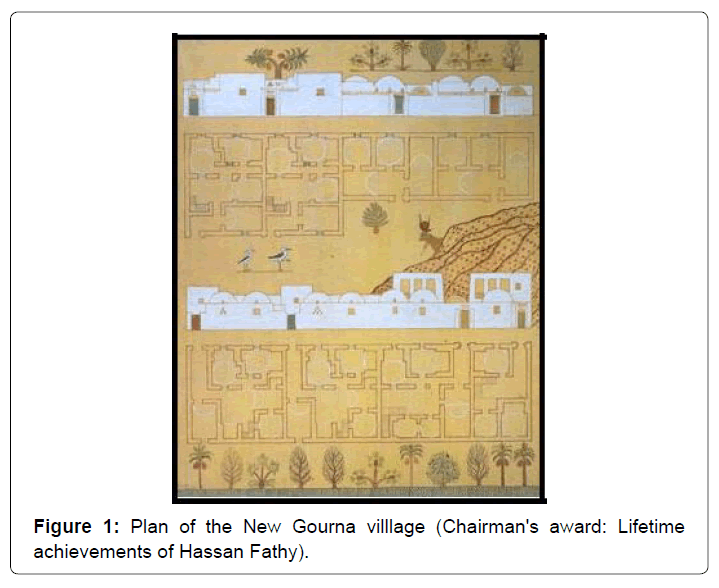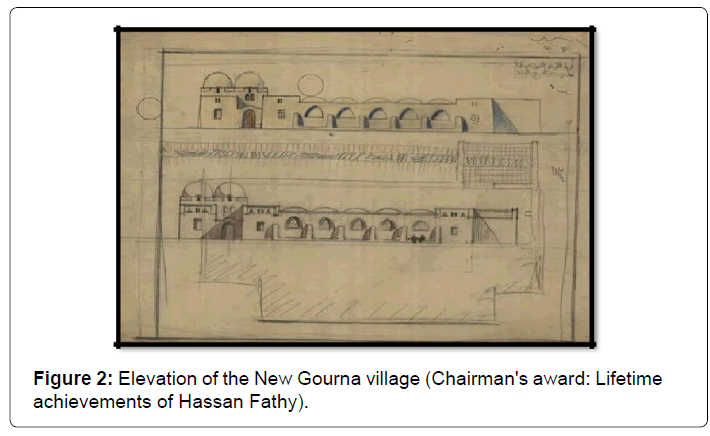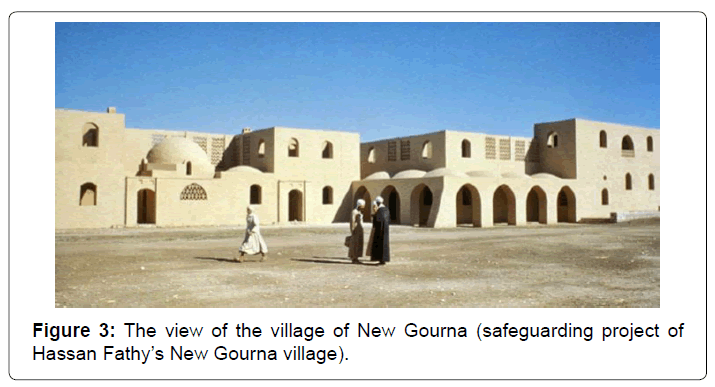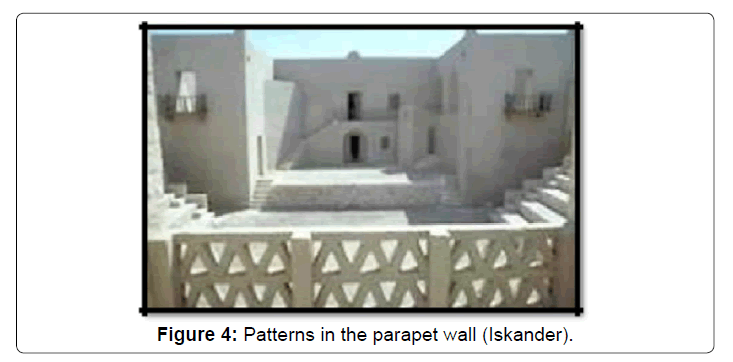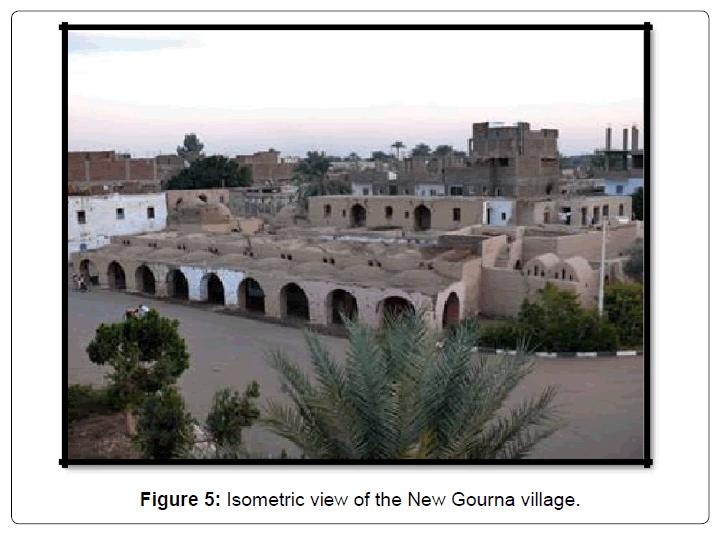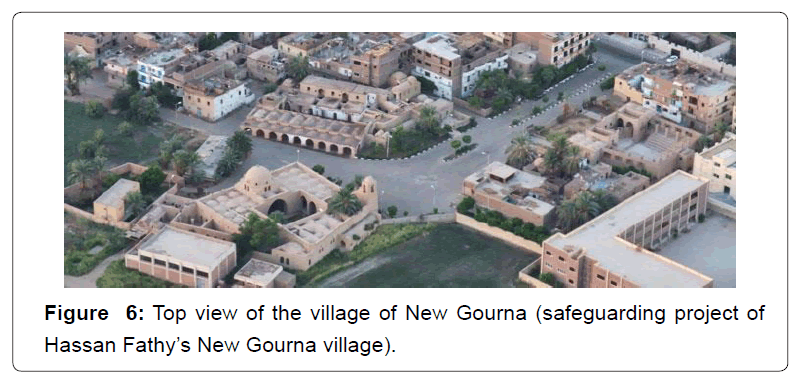Research Article Open Access
Hassan Fathys Design Efforts for New Gourna
Nandy A1 and Nandy UK2*1Chief Managing Director of the ISO Approved Firm B.U. Builders and Consultants Pvt. Ltd., Madhya Pradesh, India
2Bachelor of Architecture Degree from Maulana Azad National Institute of Technology, Madhya Pradesh, India
- *Corresponding Asuthor:
- Nandy UK
Chief Managing Director of the ISO Approved Firm
B.U. Builders and Consultants Pvt. Ltd., Madhya Pradesh, India
Tel: +91- 8878907720
E-mail: bubuildersconsultants@gmail.com
Received date: January 20, 2016; Accepted date:February 08, 2016; Published date:March 04,2016
Citation: Nandy A, Nandy UK (2016) Hassan Fathy’s Design Efforts for NewGourna. J Archit Eng Tech 5:157. doi:10.4172/2168-9717.1000157
Copyright: © 2016 Nandy A, et al. This is an open-access article distributed underthe terms of the Creative Commons Attribution License, which permits unrestricteduse, distribution, and reproduction in any medium, provided the original author and source are credited.
Visit for more related articles at Journal of Architectural Engineering Technology
Abstract
Gourna is a village located on the site of the Tomb of the Nobles that forms a part of Thebes’ ancient cementary which can now be found in Luxor, Egypt. This village that boasts of a population of seven thousand was re-developed by Hassan Fathy through his housing project. The design stands out due to the usage of traditional techniques, materials and the use of vernacular architectural solutions. The traditional wisdom, technical know-how and understanding of the natural environment have helped to shape strategies for development. Consequently, it has generated a cost-effective and ecologically sustainable building ethos that is a necessary element of the community. New Gourna village, an experimental earthen village on the West Bank of the Nile, is a testament to how the relationship between heritage and society is often fraught with multiple meanings and conflicting values.”
Keywords
Aga Khan award; Heritage; Conservation; Mud; Housing
Introduction
Gourna are various spelling for a group of three closely related villages (New Qurna, Qurna and Sheikh ‘Adb el-Qurna) located on the West Bank of the River Nile opposite the modern city of Luxor in Egypt near the Theban Hills. The construction of the village of New Gourna began in the year 1946 and continued till the year 1952 [1]. The village was built partially during this period. New Gourna lies on the western sides of the bank of the River Nile. It is situated in Luxor within the World Heritage property of Ancient Thebes in Egypt [1].
The project is considered to be one of the finest works of the architect Hassan Fathyn this book, “Architecture for the Poor: An Experiment in Rural Egypt”, published in the year 1976 Fathy gained immense recognition for his design efforts at the New Gourna [1]. The idea and concept of building a cost-effective and aesthetically appealing village was developed by the Egyptian Department of Antiquities [2]. The village was meant for addressing the relocation issues of the entrenched community of entrepreneurial excavators. Such excavators had earlier occupied the royal necropolis at Luxor [3]. This community had created a shelter above the tombs of the ancient and historic cemetery of Thebes. Thus, the Pharanoic Tombs became vulnerable and prone to damages [1].
The works at New Gourna’s village left incomplete in 1952 were completed later by UNESCO. In collaboration with the Ministry of Culture of Egypt and the Governorate of Luxor, UNESCO initiated the task of safeguarding the New Gourna’s village in the year 2009 (Figure 1). While carrying out the task, UNESCO particularly emphasized to maintain the relevance of the pioneering designs and philosophies of the architect’s efforts as well to establish their significance in relation to the contemporary sustainability concerns [1].
Throughout his lifetime, Fathy worked to evolve better living conditions for the poor people and rural improvement. Therefore, his works comprise of housing projects in the developing nations. Fathy’s efforts were aimed at creating indigenous environment, improving the living standards and economic structure of the poor people and develop cost-effective buildings. Thus the greatest benefactors were the people living in rural areas.
The design principles and the process
In order to create indigenous environment, Fathy utilizes ancient vernacular materials and design methods. Ancient wisdom of Egyptian architecture and town design strategies when incorporated with the current economic situation at Egypt facilitate the growth of a wiser design technique that helps to keep up the nation’s heritage as well. Fathy took the initiate to train the local residents to develop the materials from the locally available materials and to construct their own buildings (Figure 2).
Other factors that have influenced Fathy’s design include the climatic considerations, public health issues and ancient craft and workmanship techniques. One such material is the mud brick. Fathy has exploited the exceptional advantages and uses of earth as a full- fledged and primary construction material. The aim of Fathy has been to incorporate traditional wisdom and locally available materials for construction purposes. Thus, not only does it lead to the costeffectiveness boosting of the economy of the construction but also establishes itself as a fine application of vernacular architecture and sustainability. Furthermore, it strengthens the connection between man and nature and that of the traditional bonding. Besides these, the philosophy of the renowned Roman architect Vitruvius of the three architectural qualities of firmness, commodity and delight also gets established. In using mud as a major construction material which is the locally and abundantly available material, the idea of commodity is conveyed to the masses.
The entire village stands as a unified and therefore strong structural mass. This clearly represents Vitruvius’s quality of firmness in structures. The aim of the architect, Fathy here is to take adequate care of the need of each occupant and to address his/her specific needs and desires. In the words of the architect, “In Nature, no two men are alike” [4]. Taking inspiration from the technique of structural massing of buildings found in ancient Egyptian era, Fathy has used dense brick walls to build the buildings and has provided traditional courtyard spaces that act as buffer spaces and provide passive cooling [4].
The essential considerations of Fathy while designing the Village of New Gourna include the socio-economic conditions, profession, family size and structure, climatic conditions specific to the region as well as the requirements and aspirations of each of the occupants [2].
Basic building blocks of Fathy’s design
Mud is used in its most common style i.e., in the form of bricks. As it is clearly understandable, mud or soil is available in plenty at the site. After the village is constructed, mud imparts it a traditional tone as far as the appearance is concerned as it can be seen in the Figure 3.
Evidently, the very significant aspect of delight can therefore be found at the site. The brown monochromatic color of mud strikingly contrasts with the color of the blue sky. This is turn provides it a delightful aesthetic appeal. Several figures such as arches, hemispherical dome, square and rectangular forms are carved out from the mud buildings. These are used as fenestrations for enhancing the ventilation system of the built-space (Figure 4).
Additionally, several chajjas comprising of beautiful shapes are carved out from the masses built of mud. These chajjas or jaalis form spectacular shadows on the opposite ground. Also, these shadows are dynamic in nature and change their orientation, shape and form depending upon the direction of sunlight. In doing so, they serve the purpose of acting as structural elements supporting the natural air conditioning and ventilation of the built-form. Apart from this, they also act as beautiful aesthetical elements for the purpose of decorating and beautifying the space. Therefore, the dual qualities of architecture of commodity and delight as laid out by the Roman architect Vitruvius are portrayed by these buildings of mud bricks [5,6].
Furthermore, the natural adhesive qualities of mud are utilized when used mud for constructing the built forms. Mud can be seen throughout the span of the village. No amount of paint or natural or synthetic colours are used to conceal the basic structural members. In no way has the architect tried to create any artificial sense of lavishness or grandeur. However, Fathy has attempted to take utmost care of every occupant and provide unique designs for each. Thus, there is a spirit of variety and multiplicity (Figure 5).
The outcome
The village carries an essence of simplicity, innocence and honesty where the mud-bricks used for construction are clearly shown and revealed. And this beauty, due to varying patterns in an atmosphere of simplicity where a monochromatic and natural colour, generates a feeling of content and delight.
The simple and monochromatic colour of mud unifies the entire village as a single unit. The public units such as the Khan and the markets blend with the similarly coloured residential units. It thus evokes a feeling of oneness amongst all the structural masses.
Another architectural quality which is that of firmness as explained by Vitruvius in his book, Understanding Architecture can thus be experienced in this unified built-mass. The entire village closely entwined together in a monochromatic style emphasis unity of all the built masses. Firmness in the manner in which they depict unity can be felt and experienced. Hence, the design and utilization of the space incorporates all the three qualities of architecture pointed out by Vitruvius. Firmness, commodity and delight are demonstrated in the design in various ways of its execution (Figure 6).
Conclusion
1. The village of New Gourna has been so designed by Fathy that it primarily uses the locally available materials and techniques. This fact not only imparts a vernacular character to the place’s architecture but also promotes its sustainability, resistance to climatic extremities and economy. The living spaces are affordable yet delightful and aesthetically pleasant. Moreover, the structures have the ability to remain cool during summers and retained heat during winter seasons. This property is brought about by the mud bricks which are a very useful commodity here. Furthermore, the entire built-form standing together and in a monochromatic fashion is a boastful example of firmness.
References
- Safeguarding project of Hassan Fathy’s New Gourna Village,2011.
- New Gourna Village (2015) WorldMonuments Fund.
- Steele J (1989) The Hassan Fathy Collection. A Catalogue of Visual Documents atthe Aga Khan Award for Architecture. Bern, Switzerland: The Aga KhanTrust for Culture: 16-18.
- Chairman's Award: Lifetime Achievements of Hassan Fathy.
- Archnet focus on Africa.
- IskanderL,The Village of NewGourna.
Relevant Topics
- Architect
- Architectural Drawing
- Architectural Engineering
- Building design
- Building Information Modeling (BIM)
- Concrete
- Construction
- Construction Engineering
- Construction Estimating Software
- Engineering Drawing
- Fabric Formwork
- Interior Design
- Interior Designing
- Landscape Architecture
- Smart Buildings
- Sociology of Architecture
- Structural Analysis
- Sustainable Design
- Urban Design
- Urban Planner
Recommended Journals
Article Tools
Article Usage
- Total views: 15008
- [From(publication date):
March-2016 - Apr 05, 2025] - Breakdown by view type
- HTML page views : 14034
- PDF downloads : 974

